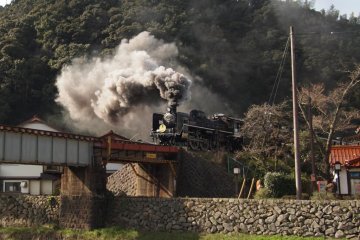The Ogori Cultural Museum and Jippotei Ishinkan are among Yamaguchi’s cultural assets, small, but playing important parts in cementing and conveying Yamuguchi’s place in Japan’s history. Ogori’s perspective is broad with niche presentations and permanent exhibits featuring Yamaguchi in general, while Jippotei focusses on the Prefecture’s militant past.

A recent niche highlight of the Ogori Museum featured Masaru Inoue, the ”Father of Japanese Railways”, who put Japan Rail on track to becoming an established part of life in Japan. Who knew. With pen and paper Inoue transformed his drawings and drafts into steaming smoke billowing engines. The Museum’s use of photographs, original documents, drafts, and models, are effective because nothing distracts from the information, handled by people from that time, and which can actually create more of an impact.

Ongoing exhibits cover the works of Santoka Taneda from Yamaguchi (1882-1940) who transformed free-form haiku into an art. A reassembled farmhouse from the Edo period (1603-1868) looks as though the occupants just stepped out for groceries. Another room displays the art and craft of the community. Ogori seems to be a communal hub, residents coming and going acting as informal guides to provide information about the Museum and Yamaguchi. But only selected photography allowed.
Jippotei is built on the grounds of the Bandai family’s residence sometime during the Edo period (1603-1868).

As supporters of the Meiji Restoration efforts, they opened their house to fellow supporters to stay and hang out. Of these, the Chōshū Five, always stand out, a group of young idealists who led Japan’s move into modernization. To name drop, notable house guests were Ito Hirobumi who became Japan’s first Prime Minister, and Inoue Kaoru, its first Foreign Minister.

The Museum contains a main reception building, the original family house, where artifacts, documents, and memorabilia, are maintained. There is also a small school for samurai retainers.

We can walk freely around the grounds with a pretty garden. The buildings look like any building of that era, but the feel of that period of history especially in terms of what it meant is pervasive.

Jippotei is supported by a live historical walking route throughout Yamaguchi, marked by the milestones of the lives of the Meiji Revolutionaries. Many are clustered around Jippotei. A large map is on the wall, and brochures are available.
Jippotei’s staff, like the folks at Ogori, are like talking repositories of knowledge, drawing us into Yamaguchi’s past. This is a hard task, history is like layers of time, inevitably - and daily - overlaid by layers of new events. So museums like Ogori and Jippotei and the people there become even more important in keeping the past– lest we forget.












